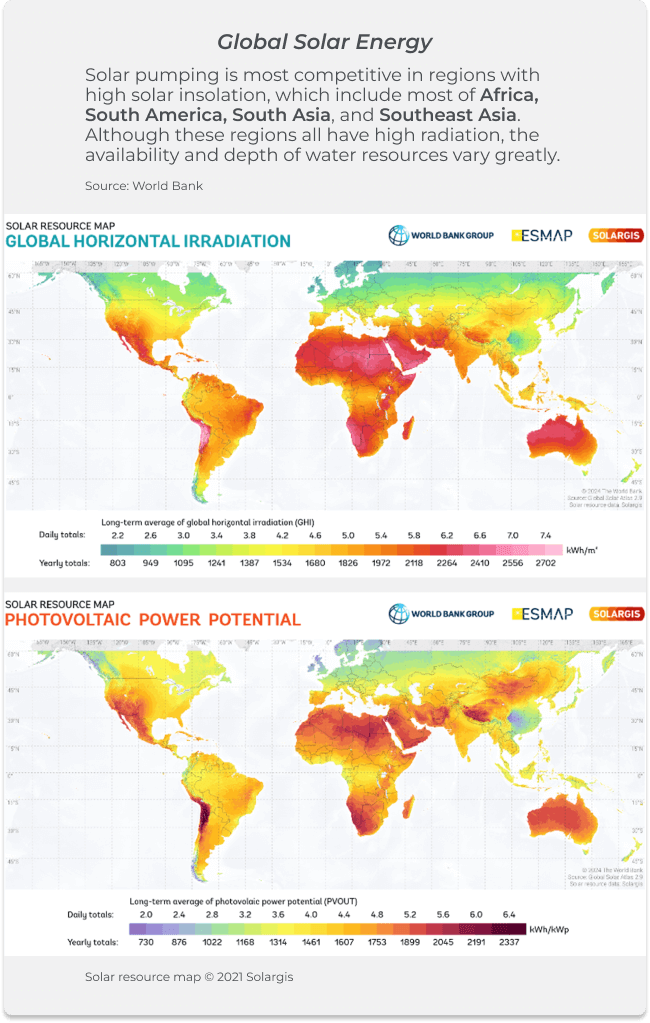Empowering Rural Communities with Solar Water Pumps: A Sustainable Solution to Global Water Scarcity
2024.09.23

Water is life, yet for over 40% of the global population, particularly in rural areas, access to clean and reliable water is a daily struggle. Water scarcity, obviously, is a pressing global issue. This is the harsh reality for over two billion people facing water scarcity - a global challenge that continues to grow with climate change and population pressures. Finding sustainable solutions has become increasingly urgent.
One such solution that has gained traction in recent years is the use of solar water pumps. And September is often recognized as a month of heightened advocacy for the Sustainable Development Goals (SDGs). The SDG 6 is CLEAN WATER AND SANITATION. Therefore, through this article, we’d like to spotlight that how solar water pumps contribute for rural areas across the globe and offer a sustainable way to address global water scarcity.

Solar Water Pumping Introduction: Basic You’d Like to Know
What Are Solar Pumps & How They Work?
Solar pumps are a type of water pump that runs on solar energy. They work by using solar panels to converting sunlight into electricity, which then powers the pump to draw water from sources like wells, rivers, or storage tanks.
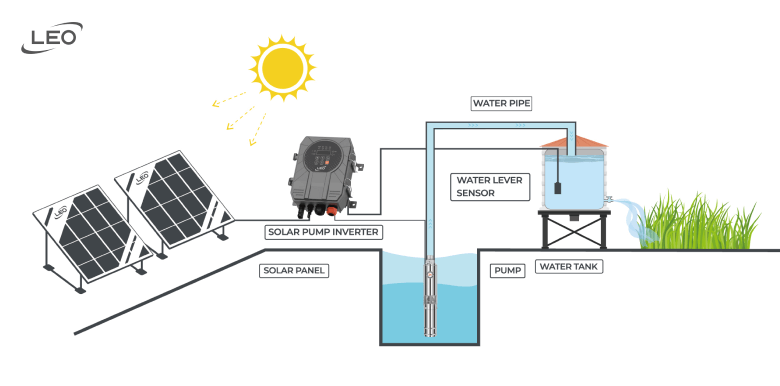
Common Solar Water Pump Types
Different solar water pumps are suited to different needs and conditions. Let us explore the regular types of solar water pump.
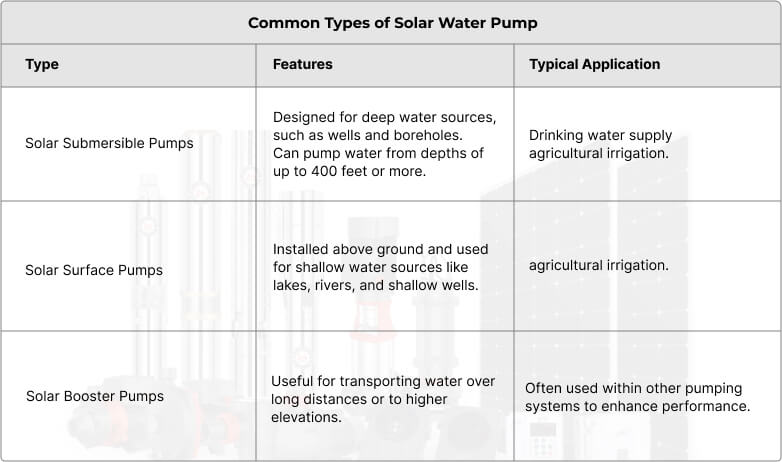
Each of these solar pump types has its own strengths, making them suitable for different environments and water access challenges. Selecting the right type depends on factors like the depth of the water source, the required water pressure, and the specific needs of the application.
What Are Solar Pumping’s Current Applications?
Because they rely on sunlight, solar pumps are most effective in sunny regions, making them ideal for remote and rural areas where access to conventional power is limited or expensive.
As that the related technologies have been improving, solar pumping systems have seen a surge in popularity across various sectors, revolutionizing water usage in remote and off-grid areas. The most prominent and common applications are:
Domestic Water Supply
Solar pumps are being installed in rural communities to ensure access to clean drinking water. In developing countries, NGOs are installing solar pumps to support clean water access initiatives, particularly in arid regions.
Agricultural Irrigation
Farmers are increasingly adopting solar pumps to ensure a steady water supply without depending on expensive and unreliable electricity.
“Solar technologies are becoming a viable option for both large and small-scale farmers. Solar powered irrigation systems (SPIS) provide reliable and affordable energy, potentially reducing energy costs for irrigation. Particularly in rural areas, where cost of diesel fuel is high or where reliable access to the electricity grid is lacking, they can provide a relatively flexible and climate-friendly alternative energy source.” - published at Food and Agriculture Organization (FAO) about Solar-powered Irrigation and On-Farm production
Livestock Watering
Solar-powered water pumps are providing consistent water supply for livestock, reducing the need for long-distance water hauling.
For instance, ranchers in Australia’s outback are using solar pumps to access groundwater for their livestock, which has proven to be a reliable and eco-friendly alternative to diesel-powered systems.
We could believe that the potential for solar pumping continues to grow, as innovations in energy storage and pump efficiency make the technology more adaptable across industries and areas. Such as, even if there is stable electricity, when the solar is sufficient enough, the solar hybrid systems, which combine solar energy with backup generators or grid power, are also considered to be used. These setups ensure water availability 24/7, regardless of weather conditions, demonstrating the versatility and reliability of solar pumping technology.
Benefits of Solar-powered Water Pumps
Solar Pumping: A Cheaper and Cleaner Way to Access Groundwater
Source from World Bank
From that you can easier understand the benefits of solar water pumps:
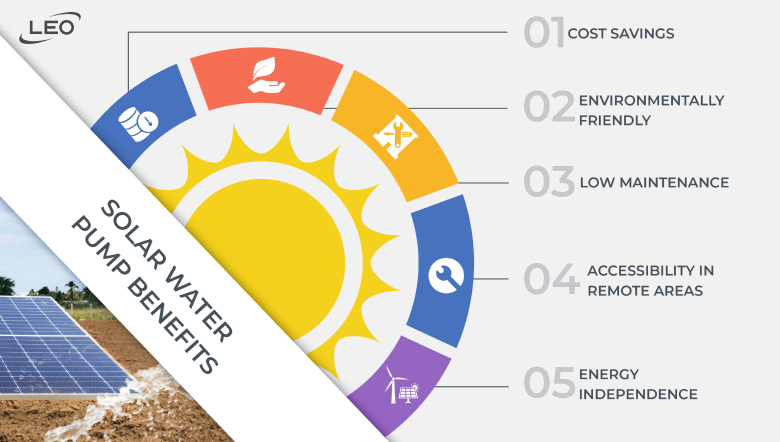
1. Cost savings
Solar pumps eliminate the need for costly grid electricity or fuel. Once installed, they harness energy from the sun, leading to long-term savings on operational expenses.
“Evidence shows that financing solar water pumps brings significant benefits for farmers. Between 2016 and 2018, Efficiency for Access partnered with 60 Decibels to survey 375 solar water pump financing customers in Uganda, Kenya and Tanzania about their experiences. Most survey respondents reported having higher incomes relative to their peers and saw their irrigation-related expenses decline by an average of 91% after adopting the new pumps (excluding the cost of financing).” – CGAP
2. Environmentally friendly
Solar water pumps rely on renewable energy, reducing carbon emissions and environmental impact. Unlike diesel or gasoline-powered pumps, they produce zero pollution, aligning with global sustainability goals.
3. Low maintenance
Solar-powered systems typically have fewer moving parts compared to conventional pumps, which reduces the risk of mechanical failures. This results in lower maintenance requirements and longer service life. Farmers in rural India, for example, report that solar pumps have helped reduce downtime and repair costs, providing more reliable water supply.
4. Accessibility in remote areas
In regions with limited or unreliable access to electricity, solar water pumps can provide a crucial solution. These systems are particularly useful in off-grid locations, where installing traditional infrastructure would be expensive or impractical. A prime example is the use of solar pumps in sub-Saharan Africa to provide water to remote villages.
5. Energy independence
Solar-powered pumps offer independence from fluctuating energy prices and fuel shortages. Users can rely on the sun as a consistent energy source, ensuring uninterrupted access to water, even during power outages or fuel crises.
Transforming Rural Communities with Solar Water Pumps
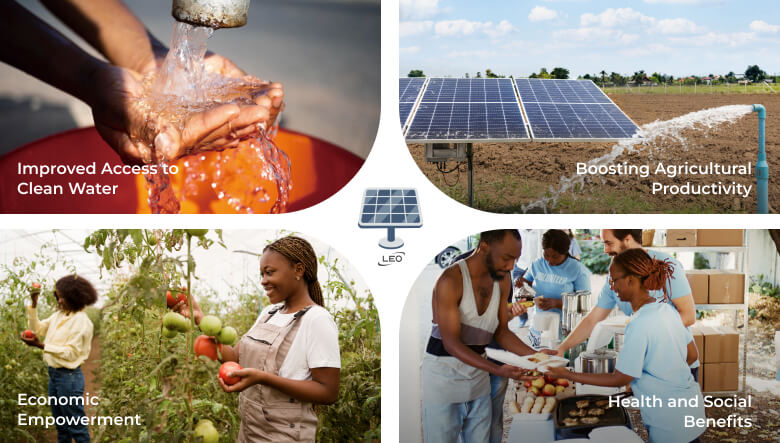
Improved Access to Clean Water
“More people have safe drinking water and sanitation but billions still go without” - SDG Report 2024 Goal 6
Traditional methods, such as diesel-powered pumps or manual wells, are often unreliable or expensive. Solar water pumps, however, offer a consistent and cost-effective solution. By utilizing solar energy, these pumps can provide a steady supply of clean water for drinking, cooking, and sanitation.
Take the example of a small village in Kenya, where a community had to rely on an old diesel pump to access water. The pump frequently broke down, leaving the villagers without water for days. After installing a solar water pump, the village now has a continuous supply of clean water, dramatically improving their quality of life.
Boosting Agricultural Productivity
Agriculture is the backbone of many rural economies, yet water shortages can severely hinder productivity.
Solar water pumps play a crucial role in supporting irrigation, ensuring that crops receive the water they need, even during dry seasons. This not only boosts yields but also extends growing seasons and supports livestock, leading to greater food security.
In India’s Rajasthan state, farmers have adopted solar water pumps to irrigate their fields. The results have been impressive: crop yields have increased by 30%, and farmers no longer need to spend large sums on diesel fuel. As one farmer put it, “The solar pump has changed our lives. We can now grow crops throughout the year without worrying about water.”
Economic Empowerment
The economic benefits of solar water pumps extend beyond just reducing energy costs. By improving access to water for irrigation, these pumps enable farmers to produce more and diversify their crops. This leads to higher incomes and new economic opportunities for small-scale farmers and entrepreneurs in rural areas.
In a remote region of Tanzania, a group of women farmers formed a cooperative to invest in a solar water pump. With consistent water supply, they were able to grow vegetables year-round, sell their produce at local markets, and increase their household incomes significantly. The cooperative model not only empowered these women economically but also strengthened their community bonds.
Health and Social Benefits
Access to clean water has a direct impact on community health. Solar water pumps help reduce the incidence of waterborne diseases by providing a reliable source of potable water. Additionally, the social benefits are profound. In many rural areas, women and children spend hours each day fetching water from distant sources. With a solar water pump, this burden is lifted, allowing more time for education, work, and other essential activities.
Sustainability and Environmental Benefits
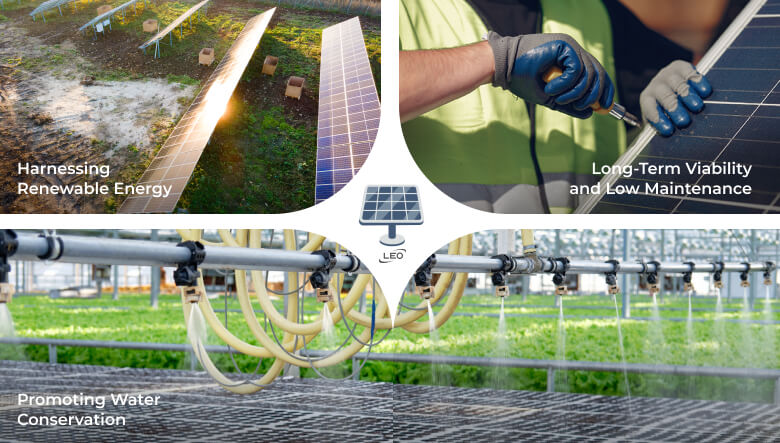
Harnessing Renewable Energy
One of the key advantages of solar water pumps is their reliance on renewable energy. Unlike diesel pumps, which contribute to greenhouse gas emissions, solar pumps operate on clean energy from the sun. This significantly reduces the carbon footprint of water pumping in rural areas.
A study by the International Renewable Energy Agency (IRENA) found that replacing diesel pumps with solar pumps in sub-Saharan Africa could reduce carbon dioxide emissions by millions of tons annually. “Solar water pumps represent a double win for rural communities,” says Dr. Amina Mohammed, a renewable energy expert. “They provide clean water while also combating climate change by reducing reliance on fossil fuels.”
Long-Term Viability and Low Maintenance
Solar water pumps are not only environmentally friendly but also highly durable and require minimal maintenance. Unlike traditional pumps that may break down frequently and require costly repairs, solar pumps have fewer moving parts and are built to withstand harsh conditions. This makes them a long-term, viable solution for water access in remote areas.
Promoting Water Conservation
In addition to providing access to water, solar water pumps can also be integrated with smart irrigation systems that optimize water use. These systems ensure that crops receive the right amount of water at the right time, reducing wastage and conserving precious water resources.
In Morocco, farmers using solar-powered drip irrigation systems have managed to cut their water usage by 40% while increasing their crop yields. This approach not only conserves water but also enhances agricultural sustainability in a region prone to droughts.
Overcoming Challenges in Solar Water Pump Adoption
Challenges
Despite their many benefits, adopting solar water pumps is not without challenges. Initial costs can be high, and rural communities may lack the technical knowledge to install and maintain these systems. Additionally, infrastructure limitations and financing barriers can hinder widespread adoption.
Solutions
To overcome these challenges, governments and NGOs are stepping in to provide subsidies, microfinancing options, and training programs.
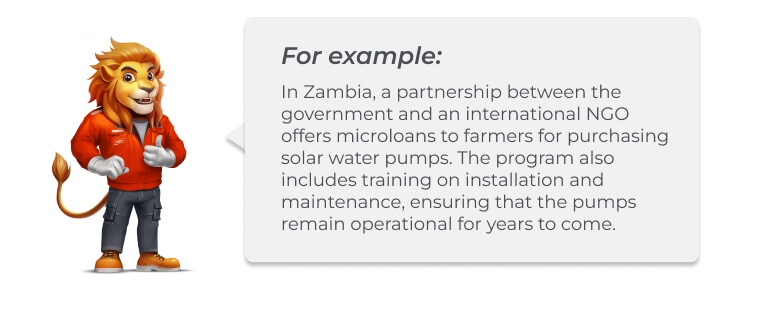
The Future of Solar Water Pumps in Rural Development
Technological Advancements
The future of solar water pumps looks promising, with ongoing innovations making them more efficient and accessible. Advances in solar panel technology, battery storage and smart irrigation systems are likely to further reduce costs and increase the adoption of solar pumps in rural areas.
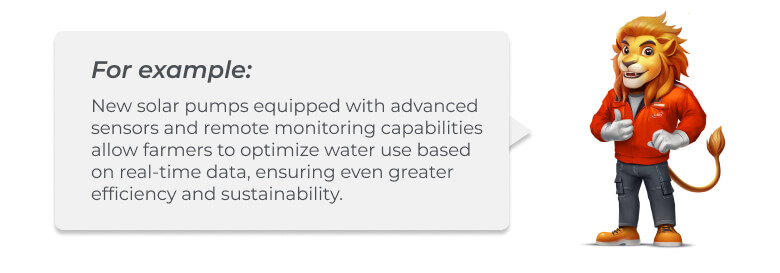
Global Impact and Scaling Up
Scaling up the use of solar water pumps globally could have a profound impact on rural development, particularly in regions most affected by water scarcity. By providing clean, reliable water, these pumps contribute to achieving several United Nations Sustainable Development Goals (SDGs), including clean water and sanitation (SDG 6), affordable and clean energy (SDG 7), and ending poverty (SDG 1).
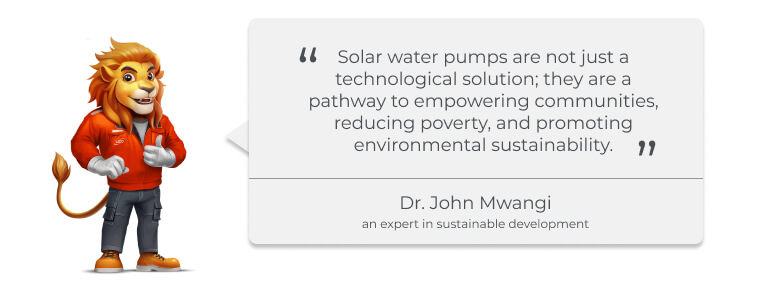
Conclusion
Solar water pumps offer a transformative solution to one of the most pressing challenges facing rural communities today: access to clean, reliable water. By harnessing renewable energy, these pumps provide a sustainable, cost-effective, and environmentally friendly way to improve water access, boost agricultural productivity, and empower rural economies. As we look to the future, the widespread adoption of solar water pumps could play a key role in addressing global water scarcity and building resilient, sustainable communities around the world.
Hot Media


LEO at Big 5 Global ...
2025.11.27


A Landmark LEO–Al Mo...
2025.12.02


LEO at the 138th Can...
2025.10.22


LEO Pro-Bono Water S...
2025.08.15

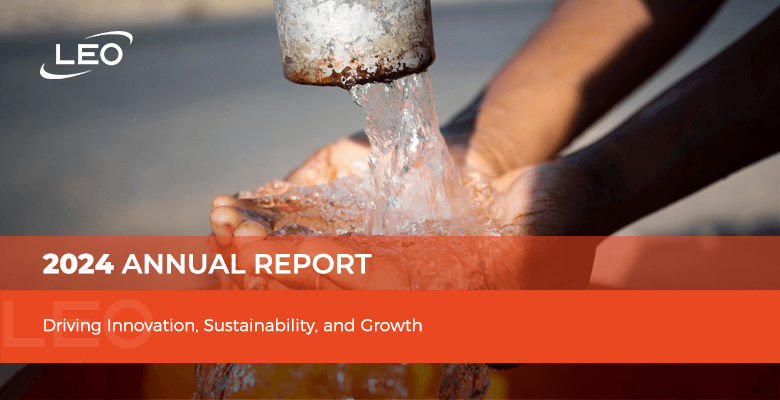
LEO PUMP 2024 Annual...
2025.05.14


A New Journey, A New...
2025.03.18


30 Years of LEO: lea...
2025.01.06


LEO at 30: United Th...
2024.12.16


A New Journey, A New...
2024.11.21


Showcasing Innovatio...
2024.10.25


LEO “Growing Forward...
2024.07.19


LEO Expands Global Q...
2024.09.06


LEO in Action: Power...
2024.08.02


LEO Event Highlight ...
2024.06.07


LEO PUMP at IFAT Mun...
2024.04.28


LEO PUMP at 135th Ca...
2024.04.01


LEO PUMP at MCE 2024...
2024.03.06


LEO PUMP at Big 5 Co...
2024.02.20


LEO PUMP at THE BIG ...
2023.11.16


LEO's Key Role in Wi...
2023.11.04


LEO at 134th Canton ...
2023.10.18


LEO PUMP at SNEC PV ...
2023.06.02


LEO Solution of Wate...
2022.09.28


LEO Project - Solar ...
2022.08.31


LEO Flagship Showroo...
2022.06.28


LEO Project on Power...
2022.06.22

